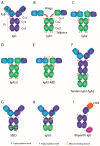Fc Engineering Strategies to Advance IgA Antibodies as Therapeutic Agents
- PMID: 33333967
- PMCID: PMC7768499
- DOI: 10.3390/antib9040070
Fc Engineering Strategies to Advance IgA Antibodies as Therapeutic Agents
Abstract
In the past three decades, a great interest has arisen in the use of immunoglobulins as therapeutic agents. In particular, since the approval of the first monoclonal antibody Rituximab for B cell malignancies, the progress in the antibody-related therapeutic agents has been incremental. Therapeutic antibodies can be applied in a variety of diseases, ranging from cancer to autoimmunity and allergy. All current therapeutic monoclonal antibodies used in the clinic are of the IgG isotype. IgG antibodies can induce the killing of cancer cells by growth inhibition, apoptosis induction, complement activation (CDC) or antibody-dependent cellular cytotoxicity (ADCC) by NK cells, antibody-dependent cellular phagocytosis (ADCP) by monocytes/macrophages, or trogoptosis by granulocytes. To enhance these effector mechanisms of IgG, protein and glyco-engineering has been successfully applied. As an alternative to IgG, antibodies of the IgA isotype have been shown to be very effective in tumor eradication. Using the IgA-specific receptor FcαRI expressed on myeloid cells, IgA antibodies show superior tumor-killing compared to IgG when granulocytes are employed. However, reasons why IgA has not been introduced in the clinic yet can be found in the intrinsic properties of IgA posing several technical limitations: (1) IgA is challenging to produce and purify, (2) IgA shows a very heterogeneous glycosylation profile, and (3) IgA has a relatively short serum half-life. Next to the technical challenges, pre-clinical evaluation of IgA efficacy in vivo is not straightforward as mice do not naturally express the FcαR. Here, we provide a concise overview of the latest insights in these engineering strategies overcoming technical limitations of IgA as a therapeutic antibody: developability, heterogeneity, and short half-life. In addition, alternative approaches using IgA/IgG hybrid and FcαR-engagers and the impact of engineering on the clinical application of IgA will be discussed.
Keywords: FcRn; FcαRI; IgA; IgG; engineering; glycosylation; half-life; neutrophil.
Conflict of interest statement
G.v.T. and M.E. are employees of TigaTx BV, and J.L. is the scientific founder and shareholder of TigaTx BV and Inc.
Figures

References
-
- Chintalacharuvu K.R., Raines M., Morrison S.L. Divergence of human alpha-chain constant region gene sequences. A novel recombinant alpha 2 gene. J. Immunol. 1994;152:5299–5304. - PubMed
Publication types
Grants and funding
LinkOut - more resources
Full Text Sources
Other Literature Sources
Research Materials
Miscellaneous

